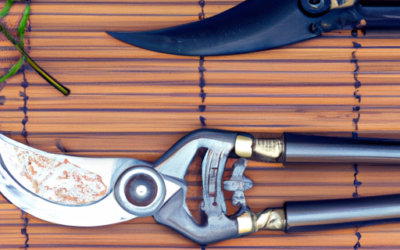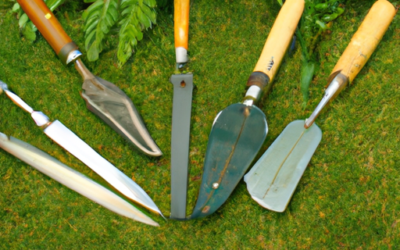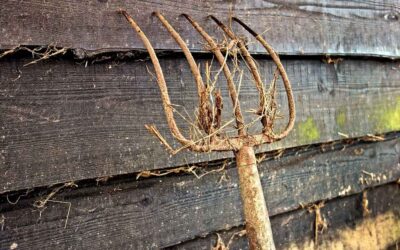Imagine tending to your beloved Japanese garden, the morn’s first light softening the edges of the meticulously groomed space. Among your gardening arsenal, you’ll undoubtedly find the root cutter to be an instrumental tool. This Buyer’s Guide is ready to spearhead an enlightening venture into the world of root cutters. Through its vast assortment of insights, you’ll find it a trustworthy companion as you select the most fitting root cutter for your tranquil sanctuary.
Understanding the Role of Root Cutters in Japanese Gardens
In the world of gardening, tools are key to producing and maintaining beautiful and healthy landscapes. One such vital tool is a root cutter, especially in the meticulous world of Japanese gardening.
Importance of Root Cutters in Maintaining Japanese Gardens
Root cutters, as their name suggests, are used to trim and cut plant roots. They are indispensable when cultivating and managing Japanese gardens, which are typically smaller and require detailed attention. The correct use of a root cutter helps to control the growth of plants, ensures easier transplanting, and allows for efficient re-potting.
Impact of Root Customization on Garden Aesthetics
Pruning and shaping plants’ roots lets you manipulate their growth style, thereby adding an artful touch to the garden’s aesthetic appeal. This customizing effect, achieved through diligent application of root cutters, is visible in bonsai plants, a classic element of Japanese gardens. By controlling roots, you can regulate a plant’s size and shape, a fundamental characteristic of the bonsai look.
Role of Root Cutters in Managing Plant Health
Trimming roots also contributes to overall plant health. Root cutters allow precise and clean cuts, which are less likely to cause damage or disease. They can be effectively used to prune rotten or overgrown roots, uphold the plant’s nutritional balance, and maintain their health.
The Anatomy of Root Cutters
Understanding the construction and functionality of root cutters is crucial to their efficient use.
Key Features of Root Cutters
Root cutters, typically held in one hand, are designed with sharp blades and sturdy handles for efficient root cutting. They are similar to pruning shears but are stronger, capable of handling thick roots. The most common type resembles pliers but with strong, scissors-like blades.
Materials Used in Root Cutter Construction
Quality root cutters are generally made of carbon steel. which ensures long lifespan and durability. The handles may be covered in plastic or vinyl, offering a comfortable grip.
Types of Blades Used in Root Cutters
The most common types of blades are straight and curved. Straight blades are ideal for cutting thicker roots, while curved blades provide more precision for intricate root work.
Different Types of Root Cutters for Japanese Gardens
A range of root cutters are available depending on the user’s level of expertise and specific requirements.
Professional Grade Root Cutters
Used by experienced gardeners and professionals, these high-grade cutters are built for heavy-duty root work. They usually feature a strong, durable blade and handles for extended usage.
Novice Grade Root Cutters
These are suitable for novice or amateur gardeners. Though slightly less powerful than professional models, they are more affordable and user-friendly, making them ideal for casual gardening.
Characteristics of Japanese-Specific Root Cutters
Japanese root cutters are globally renowned for their quality and design. They are typically made of high-grade steel and are known for delivering clean, precise cuts. Their handles are often designed to be comfortable and slip-resistant.
Choosing the Right Size of Root Cutter
Size plays a pivotal role in selecting the right root cutter.
Understanding Cutter Size in Relation to Root Thickness
The root cutter’s size should correspond to the thickness of the roots it will be used on. A larger cutter will navigate through thicker roots more comfortably, whereas smaller cutters provide ease with thinner roots.
Recommended Cutter Sizes for Different Plants
Heavier, larger cutters are recommended for trees and shrubs as they have thicker roots. For smaller plants or bonsais, lightweight, smaller cutters would suffice.
Practical Tips for Choosing Root Cutter Size
Always consider your garden size and the types of plants you frequently handle while choosing a cutter. Moreover, also consider the strength of your hands and the ease of use.
Comparative Analysis of Top Root Cutter Brands
Before purchasing, it’s crucial to consider the various renowned brands available.
Leading Manufacturers of Root Cutters
Few well-known manufacturers are Okatsune, Tobisho, and Corona. They are popular for their craftsmanship, quality, and design.
Top Rated Root Cutters in the Market
Some top-rated cutters are Okatsune Root Cutter, Tobisho SR-1 Root Cutter and Corona LR 3460 Long Reach Cut ‘n’ Hold Pruner.
Brand Reliability and Customer Reviews
Always research customer feedback and reviews before purchase. Reliable brands should offer good post-purchase services and replacements if needed.
Decoding the Pricing of Root Cutters
Price is a major factor to consider while shopping for your perfect root cutter.
Factors that Influence the Price of Root Cutters
The price range depends on several factors, such as blade quality, size, manufacturer, and materials used. Professional grades are usually higher priced than novice models.
Understanding Price Versus Quality
Bear in mind that a lower price may not last as long due to inferior materials or craftsmanship. Equally, a high price does not always guarantee superior performance.
Ways to Get Value for Your Money
Through proper research and understanding your specific needs, you can choose a high-quality, reasonably priced root cutter. Also, investing in a tool that will last longer may help you save money in the long run.
Maintenance and Care for Root Cutters
Correct maintenance and care ensure longevity of your root cutter.
Cleaning Techniques for Root Cutters
Regular cleaning after each use is crucial. Remove any dirt, sap or plant material from the blades. Use warm soapy water and a soft cloth.
Storage Tips for Root Cutters
Keep your root cutter in a dry place to prevent rusting. Some people prefer hanging them, but they can also be stored in a toolbox or a drawer.
Preventing Corrosion and Maintaining Sharp Blades
Applying oil to the blades can prevent corrosion. Regular sharpening of blades is also important to maintain their efficiency.
Safety Measures While Using Root Cutters
Safety should always be a priority when using any gardening tools, including root cutters.
Proper Handling of Root Cutters
Handle root cutters carefully to avoid injury. Ensure that your hands are dry to prevent slipping.
Protective Gear Highlights
Use protective gloves while working with cutters. It’s also a good idea to wear long-sleeved shirts to protect your arms.
First-Aid Procedures for Cutter-Related Injuries
In case of any injury, immediate first-aid should be administered. Minor cuts can be cleaned and bandaged immediately. For more serious injuries, seek medical attention.
Tips for Effective Root Trimming
While root cutters are easy to use, understanding the correct technique and timing can make a big difference.
Best Time for Root Cutting
Preferably, root cutting is done during autumn or early winter, when plants are mostly dormant.
Recommended Root Trimming Techniques
Avoid tearing or crushing the roots. Always make clean, precise cuts. For larger roots, make cuts in two steps to prevent damage.
Learning to Judge Root Health Visually
Healthy roots are firm and light in color. On the other hand, unhealthy or dead roots may appear dark, soft or brittle.
Exploring Eco-Friendly Root Cutter Options
As part of our responsibility towards the environment, finding eco-friendly options is beneficial.
Benefits of Eco-Friendly Cutters
Besides being environmentally friendly, these cutters are often sturdier and last longer than regular ones.
Leading Eco-Friendly Root Cutter Brands
Brands like Corona and ARS are known for their eco-friendly products.
Recognizing Environmentally Responsible Manufacturing Processes
Look for manufacturers that use renewable energy, recycle waste materials or use less packaging. This helps contribute to a healthier environment.
All in all, root cutters are a must-have for maintaining the harmony and beauty of a Japanese garden. From its design, size, functionality to the brands available in the market, you are now familiar with everything you need to know about these essential gardening tools, ready to make an informed choice. Happy gardening!








